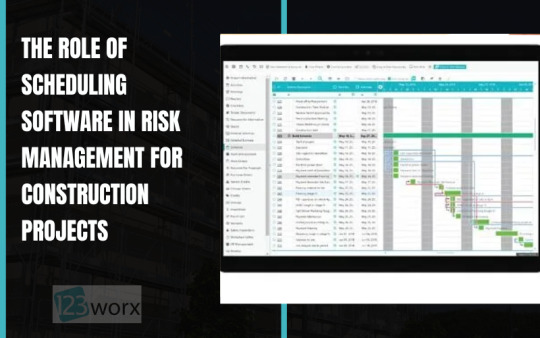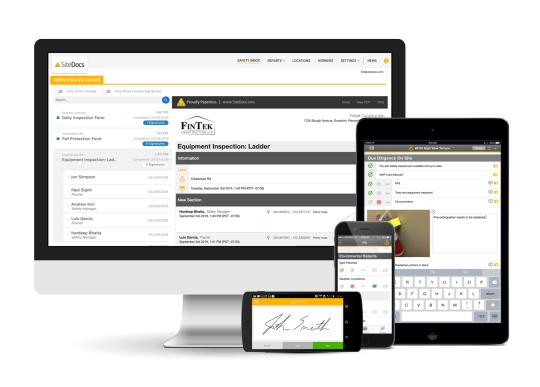#Contractor Scheduling Software
Explore tagged Tumblr posts
Text
#civil engineering#construction software#construction management software#construction management#construction scheduling software#best construction scheduling software#construction scheduling app#contractor scheduling software
0 notes
Text
Crane Rental Management Software
Equipr Software of Sippy Downs, Queensland, offers an innovative program for managing crane rental software. This program enhances operational efficiency by implementing allocation, scheduling, maintenance, and QR code systems. It is ideal for renting mobile cranes and performing civil construction. Contact Anthony Roche at 1300 100 365.
#crane rental software#crane scheduling software#equipr software#QR code systems#mobile cranes#mobile dockets#crane and rigging contractor software#crane rigging software#crane rental management software#urban cranes#allocation software#construction scheduling software
0 notes
Text
The Role of Scheduling Software in Risk Management for Construction Projects

Risk management becomes indispensable for successfully completing any project in the complicated construction world. One of the best ways project managers lessen risks is by using scheduling software.
This blog post explains how modern scheduling software identifies, assesses, and manages risks in construction projects.
As the construction sector adapts to changing times, it's becoming vital to adopt digital solutions quickly. The facility scheduling software eases the hassle of project planning. It becomes a foundation for comprehensive risk management strategies.
With effective algorithms combined with data analytics, project managers can predict and overcome challenges, making the best use of resources to ensure on-time delivery in competitive situations.
Understanding Construction Project Risks
Before the role of scheduling software is discussed, it is important to consider the types of risks that a construction project usually faces:
Time-related risks (delays)
Cost overruns
Quality issues
Safety risks
Resource allocation problems
Environmental factors
Contractual and legal risks
These risks can impact the outcome of any project that is drastically altered, making proactive risk management a necessity rather than a luxury.
How Scheduling Software Enhances Risk Management?
1. Early Risk Identification
Modern scheduling software allows the project manager to input much information about the project, including activities, dependencies, and resource requirements. It interprets the information and identifies risks early in the project, such as:
Overlapping critical path activities
Resource conflicts
Unrealistic deadlines
Early identification provides the team with ample time to act and build mitigation strategies before an identified risk escalates into problems.
2. Scenario Planning and What-If Analysis
One of the most powerful features of advanced scheduling software is multi-scenario runs. This "what-if" analysis enables the project manager to:
Test different project timelines
Assess the impact of possible delays
Assess resource allocation strategies
It enables teams to simulate different scenarios to create contingency plans for any possible event and makes them ready for unexpected outcomes.
3. Real-time tracking of progress
Scheduling software provides real-time visibility of the progress at work. This becomes very important in the case of risk management because it aids the project manager in:
Identify deviations from the planned schedule.
Spot trends that might indicate emerging risks
Data-driven decisions to keep the project on track
Real-time tracking ensures that risk management is continuous during the project life cycle.
4. Resource Optimization
Most construction projects carry a lot of risks in terms of resource allocation. Advanced scheduling software reduces such risks by:
Providing clear visibility of resource availability.
Optimizing resource allocation across multiple projects
Identifying potential resource conflicts before they arise.
Scheduling software minimizes delays and increased costs due to poor resource management since it ensures efficiency in resource utilization.
5. Improved Communication and Collaboration
Effective risk management requires proper communication among all parties. Scheduling software makes this possible by:
Providing a centralized platform for project information
Enabling easy sharing of updated schedules and risk assessments.
Allowing team members to collaborate on risk mitigation strategies
Improved communication ensures common viewpoints among all team members over project risks and mitigation plans.
6. Historical Data Analysis
Many scheduling software solutions can enable the storage and analysis of data at a company for past jobs. Historical data is paramount for risk management, primarily because it does the work of:
Identification of common risk patterns across projects
More accurate risk assessments based on experience
Continuous improvement of the risk management strategies
In learning from past projects, teams are more capable of predicting and mitigating risks in the future.
Best Practices Using Scheduling Software in Risk Management
The following are best practices that can be considered to maximize the benefits of scheduling software for risk management:
Integrate risk registers: Make sure your scheduling tool can integrate or include a risk register in which you identify risks, potential impacts, and mitigation strategies.
Regular updates: It should be a principle to keep the project schedule updated so that the ongoing risk assessments are appropriately based on timely information.
Training the team: Use training to enable all members to learn how to use this scheduling software for risk management.
Custom alerts: You may also set custom alerts across your scheduling software that can ensure the right team members are alerted about potential risk events or schedule deviations.
Reporting features: Leverage the reporting capability of your scheduling software in coming up with regular risk assessment reports to stakeholders.
Integration with Building Information Modeling (BIM)
One of the big developments in managing construction projects is integrating scheduling software with Building Information Modeling. A strong synergy is developed that enhances the capability for risk management:
1. Clash Detection and Resolution
BIM integration can help in the early detection of spatial conflicts between various building systems, such as structural, mechanical, and electrical. Linking the 3D model with the project schedule enables the teams to:
Identify potential clashes before they turn into on-site problems
Visualize the construction sequence to identify logistical issues.
Reduce rework and, therefore time and cost overruns
2. 4D Scheduling
Schedules that integrate 3D models with time information make them 4D. Such visualization of project timing supports:
Communicating complex schedules more effectively to stakeholders.
Identifying possible safety hazards at various stages in a project
Optimizing on-site logistics and material delivery schedules
3. Improved Cost Estimation and Control
This link of BIM data with the construction scheduling software for small business now allows project managers to:
Produce more accurate cost estimates from detailed quantity takeoffs.
Track costs instantly as the project proceeds.
Identify early potential cost overruns and implement mitigation strategies.
Integrating BIM with scheduling software makes identifying and managing risks at each stage of a project cycle remarkably easier to accomplish for the team.
Artificial Intelligence and Machine Learning in Scheduling Software
Recently, AI and machine learning algorithms in advanced integrated management scheduling software are increasingly rewriting the rules for performing integrated risk management on a modern, effective construction project:
1. Predictive Analytics
AI-powered scheduling software can analyze millions of lines of historical project data to identify potential risks and outcomes. With that said, project managers can:
Identify patterns that human analysts may have missed
Get early warnings about impending schedule slippages or cost overruns
Make proactive decisions informed by data-driven insights
2. Automation of Schedule Optimization
Machine learning algorithms can automatically optimize project schedules by:
Analyzing millions of possible schedule combinations
Suggesting the most efficient sequence of tasks
Balancing multi-project resource allocation
This reduces the likelihood of human error when creating schedules and supports making more realistic and achievable project timelines.
3. Continuous Learning and Improvement
AI-enabled scheduling software will learn from each project it works on, continuously improving risk prediction and suggestions for mitigation. This means:
Risk assessments become more accurate over time.
The software can adapt to a company-specific risk pattern.
Teams can leverage insights from numerous projects.
4. Natural Language Processing for Risk Identification
Some advanced scheduling software uses natural language processing to:
Analyze project documents, e-mails, and meeting notes
Identify any potential risks that might be mentioned in these communications.
Automate the updating of risk registers and notify the project manager.
It ensures that the risks communicated in different project communications are not missed and are integrated into the risk management process accordingly.
Conclusion
Scheduling software has evolved into an indispensable tool in managing construction project risks. The early identification of risk, the enablement of scenario planning, real-time tracking of progress, optimization of resources, improved communication, and the use of historical data are some of the ways these tools enhance the capability of a project team to manage and mitigate risks.
Integrating with scheduling software, BIM pushes risk management to a new level unimaginable earlier because of its visual insights and clash detection capabilities. And that's not all: integrating AI and machine learning in project management pushes it even further, with predictive analytics and auto-optimization promising a dramatic improvement in project outcomes.
As construction projects become increasingly complex, the part that construction scheduling software plays in risk management will only increase. By embracing these advanced tools and following best practices, construction companies can improve project outcomes and reduce costs, enabling their competitive advantage in the marketplace.
#construction management#construction scheduling software for contractors#construction scheduling software for small business#construction scheduling software
0 notes
Text
#Housecall Pro#Home service business#Field service management#Home service software#Business management software#scheduling software#dispatch software#invoicing software#customer management software#marketing automation#reporting tools#home service industry#business growth#field service technicians#home service professionals#Cleaners#HVAC#Plumbers#Roofers#Electricians#Handyman#Custom Remodeling#General Contractors#Garage Door professionals#Fireplace and Chimney professionals#Pest Control professionals#Pool and Spa professionals#Landscaping and Lawn professionals#Carpet Cleaning professionals#Window Cleaning professionals
0 notes
Text

#construction management software#team management software#construction project management#bim software#sub-contractor scheduling software
0 notes
Text
HVAC Service Software
#Field Force Tracker is one of the most recommended Field Service Management Software with mobile enabled used by some of the companies of H#scheduling#dispatching#invoicing and so much more.#best HVAC service software#HVAC service software for small business#HVAC software#HVAC service software#electrical contractor software#hvac service software#hvac software#hvac service software for small business
0 notes
Text

BUILDING THE FUTURE: HOW MITS LEVERAGES TECHNOLOGY FOR EXCEPTIONAL DESIGN AND CONSTRUCTION ?
MITS, a leading construction company in Noida, dives into the world of 3D modeling, BIM, and other cutting-edge advancements to revolutionize design, construction, and project management. Discover how MITS builds smarter, not just harder.Building on a Legacy of Excellence
At MITS, a premier construction company in Noida, we're passionate about exceeding expectations. We believe that the key to achieving exceptional results lies in embracing innovation. That's why we leverage the power of technology throughout every stage of the construction process, from initial design to final project delivery.
Revolutionizing Design with 3D Modeling and 3D Architecture
Gone are the days of flat, two-dimensional blueprints. MITS utilizes advanced 3D modeling software to create comprehensive, digital representations of your project. Imagine a virtual walk-through of your future building, allowing you to visualize spaces, layouts, and design details with unparalleled clarity. This collaborative approach empowers you to make informed decisions early on, minimizing the risk of costly changes later.
Enhanced Collaboration and Efficiency with BIM
Building Information Modeling (BIM) is at the heart of MITS' technological advantage. BIM goes beyond 3D modeling by integrating critical project data into the model itself. This includes information on materials, specifications, costs, and even scheduling. Imagine a single, intelligent model that serves as the central hub for all project stakeholders – architects, engineers, contractors, and you, the client. With BIM, everyone works from the same source of truth, fostering seamless collaboration, improved communication, and reduced errors.
Optimizing Project Management with Advanced Technology
The benefits of technology extend far beyond design. MITS utilizes project management software that streamlines workflows, automates tasks, and provides real-time project insights. Imagine having instant access to project schedules, budgets, and resource allocation at your fingertips. This level of transparency allows for proactive decision-making, efficient resource utilization, and the ability to identify and address potential issues before they escalate.
Beyond 3D Modeling and BIM: Embracing the Future
At MITS, we're constantly exploring the potential of new technologies. We are actively integrating virtual reality (VR) into our design process, allowing for even more immersive client experiences. Additionally, we are investigating the possibilities of drone technology for enhanced site surveying and progress monitoring.
Building a Better Tomorrow with Technology
By harnessing the power of 3D modeling, BIM, and other advancements, MITS delivers exceptional construction experiences for our clients. Our commitment to technology translates to:
Enhanced Design Quality: 3D visualization and BIM enable us to create more efficient, functional, and aesthetically pleasing designs.
Improved Project Efficiency: Integrated technologies streamline communication, minimize errors, and optimize resource allocation.
Reduced Costs and Risks: Proactive problem-solving and early decision-making lead to cost savings and reduced project risks.
Increased Client Satisfaction: Transparency, collaboration, and real-time project updates foster a positive and trusted client experience.
At MITS, we believe that the future of construction is built on a foundation of innovation. By embracing technology, we are building smarter, not just harder, to deliver exceptional results for our clients and shape a brighter future for Noida's architectural landscape.
#construction#constructioncompany#Noida#3dmodeling#3darchitecture#BIM#projectmanagement#bestconstructioncompany#constructiontechnology#innovation#architecture#design#constructioncompanyinNoida#MITS#explore
3 notes
·
View notes
Text
Vendor Versus Contractor: Understanding the Nuance for Your Small Business
While seemingly interchangeable, these roles carry distinct legal and functional implications that can significantly impact your business strategy and compliance. In this comprehensive guide tailored to small business owners, we dissect the difference between the two, providing clarity for key decisions and leading to more successful collaborations.
Who Are Vendors?
Sales cornerstones, providers of goods and services, vendors represent a fundamental aspect of the small business ecosystem. An integral part of the supply chain, vendors often ply their trade to supply the very products you sell or use to operate your business. Here are the primary characteristics that delineate a vendor:
Goods and Services: A vendor typically specializes in providing goods (inventory, raw materials) or services (e.g., marketing, software) that cater to the needs of a business or its customers.
Regular Supply Relationship: Businesses often have ongoing relationships with their vendors. The frequency and volume of orders can vary but remain steady enough to build a degree of regularity.
Product Agnostic: Vendors are usually not directly or personally involved in the end use of the goods or services they provide, contrasting with the hands-on nature of a contractor's involvement.
Who Are Contractors?
Independent, specialized, and temporarily engaged, contractors bring crucial expertise to projects without permanently joining the company's structure like an employee would. This distinction can generate unique flexibility and cost efficiencies. Characteristics that define a contractor:
Skill-Specific Services: Contractors are often hired to provide a particular set of skills or to complete a specific project, reflecting the temporary nature of their engagement.
Independence: Unlike vendors, contractors usually have more control over the way they deliver their services. They might be self-employed or work for an external agency but operate under their terms during the engagement.
Project-Centric: A contractor's involvement is often bounded by the scope of a project or a set period, after which the business and the contractor part ways, or the contract is renewed.
3 Key Differences Between Vendor and Contractor
1. Nature of Engagement
Vendors, through their ongoing provision of goods or services, establish a relationship deeply embedded within a business’s regular operations. They are part and parcel of the business's supply chain and, in essence, the extended team. On the other hand, contractors’ relationships are more sporadic, being engaged for a specific project or task over a defined period. Their autonomy in execution echoes the temporary and independent nature of their role.
2. Control and Direction
This is where legal implications, particularly concerning labor laws, are distinctly highlighted. In the case of vendors, businesses typically have less direct control or input into the vendor’s operations, especially in service provision. Contractors, on the other hand, operate under the terms set forth in a contracted agreement but maintain control over their working methods and schedules, a hallmark of their independent status.
3. Taxation and Legal Considerations
The differentiation between vendor and contractor can significantly affect how taxes are handled and what legal obligations your business carries. Vendors are typically subject to sales tax laws, while contractors often fall under income tax and self-employment tax regulations. Additionally, engaging contractors usually entails less legal liability for a business compared to that which might accompany the vendor relationship, which involves greater control by the business over the product or service.
Conclusion
The significance of discerning between vendors vs independent contractors cannot be overstated for small business owners. Misclassification can result in financial, legal, and operational setbacks that are best avoided through a clear understanding of these roles. Consider consulting with legal counsel or a small business advisor to ensure that your business interactions are compliant and conducive to your growth. With this understanding, you can harness the unique advantages each role offers and cultivate a thriving ecosystem of partnerships that propels your business forward.
@erastaffingsolutions
#erastaffingsolutions#era#hrsolution#workfocesolution#eorservice#vendorsvscontractors#differencebetweenvendorandcontractor#independentcontractorvsvendor#vendorvsindependentcontractor#whatisthedifferencebetweenavendorandacontractor
2 notes
·
View notes
Text
CONSTRUCTION SAFETY COMPLIANCE
Easiest Admin Safety Document Management Software Ever:
Monitoring everything from staff qualifications & training to the expiration of driver’s licenses and insurances. Implementing updates to company policies, confirming employee recognition of alterations and updates via a completely automated, simple to handle follow-up and compliance processes.

Go Digital With All of Your Forms:
Import your own company forms, or Build custom forms that are simple to fill-out and sign with follow-up actions, worker certifications, GPS locations, and offline support.
Accountability Through Visibility:
Easily create or add your existing forms and internal documents and distribute documents and then track completion by worker, location or document name, in real-time.
Contractor Management:
The program makes it easier than ever for Primes and General Contractors to ensure participation and safety compliance from every contractor and subcontractor in site.
Scheduled Forms:
Easily create and distribute documents and then track completion by worker, location or document name, in real-time.
Discover Insights:
Unlock the Power of Data Driven Safety. Analyse your safety program to identify trends and monitor KPIs using the most user friendly and advanced reporting engine on the planet!
Remember, a Safety Management System is not just about having safety measures in place; it’s about making safety a core value in your organization. So, start implementing SMS today and make your workplace a safer place for everyone.
2 notes
·
View notes
Text
iFieldSmart Technologies: The Best Construction Scheduling Software Solution
In the complex world of construction project management, effective scheduling is the linchpin of success. Construction scheduling software has emerged as an indispensable tool, replacing outdated manual methods and ushering in a new era of efficiency and collaboration. However, not all construction scheduling solutions are created equal.
This article delves into the challenges posed by legacy software, explores the transformative benefits of modern solutions, and highlights why iFieldSmart Technologies stands out as the premier choice for contractors and construction professionals.

Outdated Construction Scheduling Software: The Bottlenecks -
Traditional construction scheduling software often suffers from critical limitations:
Siloed Communication: Many legacy systems lack integrated communication features, leading to information delays, miscommunication, and coordination challenges among project stakeholders.
Manual Updates and Errors: Arduous manual schedule updates are prone to errors and can quickly become outdated in dynamic construction environments.
Limited Real-Time Visibility: Outdated software fails to provide real-time insights into project progress, hindering proactive decision-making and risk mitigation.
Integration Hurdles: Integrating legacy systems with other essential project management tools is often cumbersome, creating data silos and impeding comprehensive project oversight.
.
Modern Construction Scheduling Software: The Game-Changer -
Cutting-edge construction contractor scheduling software addresses these pain points and delivers substantial advantages:
Streamlined Efficiency: Automation of repetitive tasks, error reduction, and optimized resource allocation translate to significant efficiency gains throughout the project lifecycle.
Enhanced Collaboration: Centralized platforms foster seamless communication and document sharing, ensuring all team members and stakeholders are aligned and informed.
Data-Driven Insights: Real-time data empowers project managers to make informed decisions, identify potential bottlenecks, and mitigate risks proactively.
Cost Control and Savings: By minimizing delays, optimizing resource utilization, and preventing budget overruns, modern software translates to substantial cost savings.
Transparency and Accountability: A comprehensive and transparent view of the project schedule fosters accountability across all project participants.
.
iFieldSmart Technologies: Your Construction Scheduling Powerhouse-
iFieldSmart Technologies has solidified its position as a frontrunner in the construction scheduling software arena. Its distinct advantages include:
Intuitive User Interface: The platform boasts a user-friendly interface that simplifies complex scheduling tasks, even for users with limited technical expertise.
Robust Feature Set: iFieldSmart Technologies offers a comprehensive suite of features, including Gantt charts, critical path methodology (CPM) analysis, resource leveling, and real-time progress tracking.
Mobile Accessibility: The construction scheduling app ensures that project teams can access and update schedules on the go, enhancing flexibility and responsiveness.
Seamless Integrations: iFieldSmart Technologies integrates seamlessly with popular project management tools, creating a unified project ecosystem.
Unparalleled Support: A dedicated customer support team ensures that users receive prompt assistance and guidance, maximizing their experience with the software.
.
The AI-Powered Future of Construction Scheduling: A Paradigm Shift –
Artificial intelligence (AI) is poised to revolutionize the construction scheduling landscape. Beyond streamlining existing processes, AI-powered algorithms are set to transform how projects are planned and executed.
Imagine AI analyzing historical project data to identify patterns and trends, accurately predicting potential delays, and optimizing resource allocation in real-time. Machine learning models can learn from past projects, continuously improving their predictive capabilities.
Furthermore, AI can generate alternative schedules, assessing the impact of various "what-if" scenarios on project timelines and costs. This empowers project managers to make informed decisions proactively, minimizing risks and maximizing efficiency. The integration of AI into construction scheduling is not just an incremental improvement; it's a paradigm shift that promises to reshape the industry's future.
.
10 Essential FAQs on Selecting the Best Construction Scheduling Software-
1. What are the key features to look for in construction scheduling software?
Prioritize features like Gantt charts, critical path method (CPM) analysis, resource leveling, real-time progress tracking, mobile accessibility, and seamless integration with other project management tools.
2. How does construction scheduling software improve project efficiency?
By automating tasks, reducing errors, optimizing resource allocation, and providing real-time insights, it streamlines workflows, minimizes delays, and enhances overall project efficiency.
3. Is it essential to have a mobile app for construction scheduling?
Yes, a mobile app is crucial for field teams to access and update schedules on-site, ensuring everyone stays informed and can respond to changes promptly.
4. Can construction scheduling software integrate with my existing project management tools?
Most modern software offers integration capabilities with popular project management tools like Procore, Autodesk Construction Cloud, and Microsoft Project, ensuring data consistency and a unified project view.
5. What is the pricing model for construction scheduling software?
Pricing varies across providers. Some offer subscription-based models, while others charge per user or project. Research and compare different options to find the best fit for your budget.
6. Is there a free trial available to test the software before committing?
Many reputable providers offer free trials or demos, allowing you to explore the software's functionality and user interface before making a purchase decision.
7. What kind of customer support is available for construction scheduling software?
Look for providers that offer comprehensive customer support, including online resources, tutorials, webinars, and responsive customer service to address any issues or questions you may have.
8. How does artificial intelligence (AI) impact construction scheduling software?
AI is increasingly integrated into construction scheduling software, enabling features like predictive analytics, risk assessment, and automated schedule optimization for improved decision-making.
9. Can construction scheduling software help with resource management?
Yes, many platforms offer resource management features, allowing you to allocate resources efficiently, track their utilization, and avoid over allocation or underutilization.
10. What are the long-term benefits of investing in construction scheduling software?
Investing in a robust construction scheduling solution can lead to significant long-term benefits, including increased project profitability, improved client satisfaction, enhanced reputation, and a competitive advantage in the market.
.
Conclusion :
Best construction scheduling software has become a non-negotiable asset for modern construction projects. iFieldSmart Technologies, with its intuitive interface, robust features, mobile accessibility, and dedicated support, emerges as the definitive choice for contractors and construction professionals seeking a competitive edge in a dynamic industry. By harnessing the power of data and AI, iFieldSmart Technologies is shaping the future of construction scheduling.
Visit: www.ifieldsmart.com/scheduling
#Construction Scheduling Software#Construction Scheduling App#Contractor Scheduling Software#Best Construction Scheduling Software#civil engineering#construction software#construction management software#construction management#iField
0 notes
Text
Architectural Drafting is Key for Construction Drawings & As built Drawings

In the dynamic realm of construction, precision and clarity are of paramount importance. Behind every structurally sound and aesthetically pleasing building lies a meticulously crafted blueprint. Architectural drafting serves as the bedrock upon which these blueprints, construction drawings, and as built drawings are created. With the advent of Computer-Aided Design (CAD) services and Building Information Modeling (BIM) services, architectural drafting has undergone a transformative evolution, revolutionizing the construction industry.
The Essence of Architectural Drafting:
Architectural drafting is the process of creating detailed technical drawings that serve as the visual roadmap for constructing a building. These drawings encompass a wide range of information, including dimensions, materials, layout plans, elevations, sections, and intricate details. In essence, architectural drafting is the language through which architects, engineers, and contractors communicate their vision and collaborate to bring structures to life.
Precision and Clarity:
The success of any construction project hinges on accuracy. Construction drawings derived from architectural drafting must be precise down to the last millimeter, leaving no room for ambiguity. A misplaced dimension or an unclear annotation could lead to costly errors during construction, compromising both safety and budget. Architectural drafting ensures that every stakeholder, from architects to construction workers, shares a common understanding of the project's intricacies.
The Evolution of CAD Services:
The introduction of CADservices revolutionized architectural drafting. Traditional manual drafting was time-consuming and prone to errors. CAD software streamlined the drafting process, enabling professionals to create, edit, and replicate drawings with unprecedented efficiency. Dimensions could be automatically updated, and intricate designs could be visualized in 3D, providing a more immersive understanding of the project.
CAD services not only expedited drafting but also enhanced collaboration. Professionals from different disciplines could work on the same digital platform, ensuring seamless integration of architectural, structural, and mechanical designs. This level of coordination minimizes conflicts and optimizes the construction process.
BIM Services: A Paradigm Shift:
While CAD services brought efficiency to drafting, Building Information Modeling (BIM) services marked a paradigm shift in how construction projects are conceptualized, designed, and executed. BIM extends beyond mere 3D modeling; it involves the creation of a comprehensive digital representation of a building's physical and functional characteristics.
BIM-enabled architectural drafting transcends static drawings. It encapsulates information about materials, costs, scheduling, and even environmental impact. This holistic approach allows stakeholders to visualize the building's entire lifecycle, from initial design to construction, operation, and maintenance.
One of the key benefits of BIM services is its impact on as built drawings. As built drawings represent the final state of a building, including any modifications or deviations from the original plan that occurred during construction. With BIM, as built drawings are not mere post-construction documentation; they are a dynamic record that captures real-time changes and forms a valuable resource for future renovations or repairs.
The Symbiotic Relationship: Architectural Drafting, CAD, and BIM:
Architectural drafting, CAD services, and BIM services form a symbiotic relationship that empowers the construction industry. CAD services provide the agility and accuracy required for efficient drafting, allowing professionals to create intricate designs with ease. BIM services elevate this process by introducing collaboration and information-sharing, resulting in a digital twin of the physical building.
The marriage of CAD and BIM ensures that as built drawings are accurate reflections of the constructed building. Deviations from the original plan can be promptly updated in the digital model, maintaining the accuracy of the as-built documentation. This synergy minimizes the gap between the design intent and the final product, offering architects, contractors, and building owners a comprehensive overview of the structure.

In the ever-evolving landscape of construction, architectural drafting remains the linchpin of accurate construction drawings and as-built documentation. The integration of CAD services and BIM services has transformed this once manual process into a dynamic, collaborative, and technology-driven endeavor. The precision offered by architectural drafting, bolstered by CAD's efficiency and BIM's comprehensive approach, ensures that construction projects are executed with meticulous accuracy. As we look to the future, the continued evolution of architectural drafting alongside advancing technologies promises even greater strides in the construction industry, solidifying its foundation on a bedrock of precision and clarity.
2 notes
·
View notes
Text
How Scheduling Software Can Help Small Contractors Compete with Larger Firms?

Small contractors often struggle in the highly competitive world of construction, competing against bigger and more established companies. However, new and advanced scheduling software turned out to be such a game-changer that it allows smaller operations to punch above their weight class. Understanding how the scheduling software positions small contractors toe-to-toe with their bigger competitors ultimately revolunize our perspective on project management and business expansion.
The Challenges Faced by Small Contractors
Before offering the solutions, it's essential to identify the challenges that small contractors commonly encounter in the present building environment:
Limited resources and manpower
Tighter budgets for investment in technology
Less developed processes and systems
Inability to manage more than one project simultaneously
Obstacles to attracting and retaining qualified labor
Limited access to sophisticated instruments and technologies
Struggle to maintain steady cash flow.
Difficulty in scaling operations efficiently
Despite such obstacles, construction scheduling software for small business acts as a helpful tool. It helps small contractors rise up and play fair in the competitive field.
Key Benefits of Scheduling Software for Small Contractors
1. Enhanced Project Planning and Execution
Scheduling software empowers small contractors with the capability to plan and execute projects with a level of detail that is no different from large firms. This has several advantages:
Dependencies of detailed task breakdown.
Resource allocation optimization
Automatic schedule updates based on progress
What-if scenario planning for risk management
Critical path analysis identifying key project elements
Milestone tracking and reporting
These features enable small contractors to build more accurate timelines, manage resources more effectively, and provide the same professionalism within their quotes as larger competitors.
2. Improved Utilization of Resources
One of the greatest difficulties small contractors face is maximizing the use of their very limited resources. Scheduling software performs this by:
Provide real-time visibility to Resource Availability.
Optimizing Crew Assignments Across Multiple Projects
Identifying potential resource conflicts before they occur.
Facilitate the scheduling of equipment and materials.
Tracking labor productivity and utilization rates
Enabling just-in-time material ordering to reduce storage costs
This level of resource management allows small contractors to take up more projects without overstretching themselves, hence competing effectively with larger firms that may have more significant amounts of resources at their disposal.
3. Enhanced Communication and Cooperation
Communication indeed plays a vital role in construction, and here is where the scheduling software has proven to work best:
A centralized platform with all project information
The system allows real-time updates to be accessible to all team members.
Automated notifications in case of any schedule change or delay
Easy sharing of the project timeline with clients/stakeholders.
Collaboration tools for remote teams and subcontractors
Manage documents to ensure ease of access to plans and specifications.
Small contractors can communicate all this through better relations and can present themselves as more professional in carrying out projects as swiftly as larger firms that have greater coordination.
4. Data-Informed Decision Making
Scheduling software is a powerful analytics tool for small contractors in that it:
Performance tracking against planned schedules
Identification of bottlenecks and inefficiencies
Analyzing historical data to make better plans for the future.
Improvement through KPI tracking
Predictive analytics to proactively address problems
Cost variance analysis to ensure better budget control.
It gives small contractors valuable insights critical to informed decision-making relatively fast, thus helping them adapt quickly to the sort of agility larger firms often lack.
5. Increased Bidding Accuracy and Competitiveness
One of the most essential benefits of scheduling software to a small contractor is making more realistic bids.
Accurate cost estimates with detailed resource allocation
More realistic timeline-risk assessment tools
Historical data utilization for more accurate pricing
Ability to quickly provide various bid option scenarios
Integration with cost databases for up-to-date material and labor prices
Automated takeoff capabilities calculate quantities more accurately.
Such a level of precision and flexibility in quotation allows the small contractor to compete better for projects, often underpricing larger firms yet still realizing good profitability.
6. Mobile Accessibility and Field Updates
All the latest scheduling software is capable of working on mobile devices, especially for the small contractor:
Live updates from the field
Viewing of on-site project schedules and information
Time and attendance tracking of field workers
Photo uploads and document attachments to support reporting of progress
GPS tracking for equipment and vehicle management
Digital forms for safety inspections and quality control
This means, in other words, that this mobile accessibility enables the small contractor to have real-time control over the project, which is possible in firms with larger field management teams.
7. Integrating with other business information systems
Most of the scheduling software solutions have integrations to other business systems.
Affordable accounting software to track your budget and invoice clients
CRM systems for managing clientele
Inventory management for materials tracking
Payroll and time-tracking HR systems
BIM for better visualization of the project at hand.
E-commerce platforms for seamless material procurement.
Such integrations will allow small contractors to establish an end-to-end business management ecosystem, like what enterprise systems have been pitching for larger firms.
Overcoming Implementation Challenges
While there is clearly a lot to be gained, the small contractor has some significant barriers to the implementation of scheduling software:
Cost Concerns: Most software providers offer solutions that can grow with the operation and have pricing tiers for smaller operations. Consider starting with essential features and working your way up as business dictates.
Training and Adoption: Find vendors with more intuitive interfaces and better customer support, which will drastically reduce the learning curve. Most of them should be able to give online tutorials and training resources to help your team get up to speed quickly.
Data Migration: Only begin with critical data and grow your database naturally. Start first with active projects or in the future; then, when time allows, go back and add old data.
Resistance to Change: Involve your team in the selection process. Highlight the benefits derived from using the new software in order to win people over. Explain how it will make lives easier and more efficient.
Technical Infrastructure: Make sure your hardware and the speed of your internet can handle a specific software need. Cloud-based solutions do not typically require in-depth upfront investment in IT infrastructure.
The Future of the Small Contractor in a Technology-Driven Industry
In the present developmental scenario, it's essential for the construction business to embrace tools like scheduling software. It isn't just about staying competitive; it's about survival. Small contractors must adapt to have a competitive edge. The small contractors who are able to use these tools effectively will be in a better position to:
Compete for larger, more complex projects
Improve profit margins by managing resources more diligently
Attract top talent by offering them modern and efficient work environments.
Scale up operations more effectively.
Improve client relationships through better communication and project delivery.
Those who can fully adapt and utilize technology, be it major corporations or single-owner businesses, hold the future of construction. Small contractors can use scheduling software not only to compete but even to outshine larger firms.
Conclusion
Scheduling software has become one of the great equalizers in the construction business, allowing small contractors to be more competitive with larger firms. These solutions give small contractors the ability to take on larger projects and deliver them like their bigger competitors through project planning enhancements, enabling better resource management, enhanced communication, and insightful data-driven decisions.
Hence, going forward, technology's role in shaping the success of construction companies of all sizes is set to increase. Small-scale contractors most likely to be better equipped for the challenges of the industry, realize new opportunities, and develop their businesses in an increasingly competitive marketplace will be those utilizing scheduling software coupled with other technological advancements.
While finding the right solution that matches your requirements is important, coupled with adequate training and implementation, the key to success always lies in how consistently you apply the insights and efficiencies that you get in running improvement operations. With the proper approach, the scheduling software can clearly act as a springboard for small contractors looking at competing, winning bids, and being really formidable players in the construction market.
#construction scheduling software#construction scheduling software for small business#construction scheduling software for contractors
0 notes
Text

USAF is ready to accept the T-7s, flight tests start in the 'next few weeks'
Fernando Valduga By Fernando Valduga 12/08/2023 - 20:01in Military
The U.S. Air Force will officially take ownership of its first production T-7A training jet “in the coming weeks” and will quickly move on to flight tests at the Boeing contractor's facility in St. Louis, a service officer said last week.
After that, the first two Red Hawks will be transferred to Edwards Air Base, California, within "September" to continue testing, T-7 division chief Colonel Kirt Cassell told reporters at the Life Cycle Industry Days conference on July 31.
In April, U.S. Air Force procurement executive Andrew Hunter announced that the T-7 would not reach initial operational capacity until the beginning of 2027 - three years after its original 2024 target. Then, the Office of Government Responsibility (GAO) said in May that the relationship between the USAF and Boeing was "tend" and predicted that Boeing might not even meet the revised 2027 schedule.

Cassell said that the U.S. Air Force and Boeing have redefined their relationship since then. “There were leadership changes,” he said. "At the PEO level and at my level within Boeing, they reorganized the attack. ... And then there were many changes, which actually just gave us a new set of eyes. I have a new deputy who joined the program. So, we have a new pair of eyes and we really just invigorate our relationship."
In May and June, the first T-7 production representative began to undergo taxi tests and then made his first official flight with a USAF pilot.
Behind the scenes, Cassell said, the U.S. Air Force and Boeing have been working together to ensure that flight tests can begin as soon as the first jet, dubbed the T-2 or ATP-2, is officially transferred to the U.S. Air Force.

"The team, collectively Boeing and the U.S. Air Force, has been working overtime," Cassell said. "As if I wasn't joking, working overtime, until late at night, to overcome acceptance. We should accept this aircraft here in the next few weeks. Once completed, we worked hard to prepare for the flight tests. We have completed the appropriate test readiness reviews, these are completed. We have completed the appropriate test planning requirements."
Soon after ATP-2 is accepted by the U.S. Air Force, the service expects to appropriate a second aircraft, called T-1 or ATP-1. The two fuselages will test different factors - flight sciences and charges, respectively, Cassell said.
"There is little or nothing on our way to get this jet, ATP-2, up and running," Cassell said. "Let's start flight tests in St. Louis. And then, around September, that's when we'll transition from APT-2 and then APT-1 to Edwards for continuous flight testing."

Putting the T-7 back on track and avoiding further delays will likely be crucial to satisfy lawmakers who have expressed concerns about the program. Acclaimed at its launch for proving how engineering and digital design are innovative technologies to accelerate the launch of the product on the market, the first aircraft representative of production went from the clipboard to the first flight in 36 months.
Digital design is “completely transforming the way we do systems engineering,” said General Duke Z. Richardson, head of the Air Force Material Command, in 2022. Boeing and Saab employees predicted that this would "revolutionize" the way aircraft are designed and built.
Then came the delays. In 2021, the U.S. Air Force said that the T-7 suffered from vortex detachment at high angles of attack, making it unstable on the rolling axis. Problems arose with the jet's flight control software, and then doubts arose about the coach's ejection seat system - which was necessary to accommodate a wide range of body sizes. The USAF and Boeing discussed the test data and how to interpret it.

In May, USAF Secretary Frank Kendall suggested that digital engineering had been "exaggerated" as a way to reduce development time and cost, warning that there are no shortcuts to testing in the real world.
Boeing and the U.S. Air Force now say that the T-7 problems have been largely fixed. But the legislators are skeptical. A provision in the House version of the National Defense Authorization bill would require the Air Force to assess the "risks associated with the overlap of the development, testing and production phases of the program and risks related to the management of contractors". It is not yet known whether this provision will survive the House-Senate conference to reconcile the versions of the House and Senate bill.
Source: Air Force & Space Magazine
Tags: Military AviationBoeing T-7A Red HawkUSAF - United States Air Force / U.S. Air Force
Sharing
tweet
Fernando Valduga
Fernando Valduga
Aviation photographer and pilot since 1992, has participated in several events and air operations, such as Cruzex, AirVenture, Daytona Airshow and FIDAE. He has works published in specialized aviation magazines in Brazil and abroad. Uses Canon equipment during his photographic work around the world of aviation.
Related news
INTERCEPTIONS
RAF Typhoons intercepted 50 Russian aircraft during air policing mission in Estonia
12/08/2023 - 13:47
HELICOPTERS
Germany will have NATO's second largest fleet of helicopters
12/08/2023 - 12:12
MILITARY
Ukrainian Air Force lost 62 planes in 2022. So far, in 2023, he has lost only seven.
11/08/2023 - 19:35
MILITARY
Russian Aerospace Forces received new batch of modernized MiG-31 interceptor fighters
11/08/2023 - 16:00
MILITARY
Tunisia receives its latest T-6 Texan II training aircraft
11/08/2023 - 13:00
MILITARY
VIDEO: Finnish Air Force demonstrates takeoff and landing on the highway
3 notes
·
View notes
Text
The latest Sub-contractor Scheduling Software is remarkable for the right reasons.
Construction projects are complex endeavors that require precise coordination among various stakeholders. Sub-contractors play a crucial role in the successful execution of these projects, but scheduling their activities can present significant challenges.
In this article, we will explore the obstacles faced by sub-contractors during construction scheduling and highlight the top benefits of efficient sub-contractor scheduling software. We will also discuss how iFieldSmart Technologies can support sub-contractors with accurate and effective scheduling, along with best practices for field scheduling.

Challenges Faced by Sub-contractors during Construction Scheduling:
According to a study by FMI Corporation, poor project scheduling is one of the top causes of delays in construction projects, accounting for 30% of project delays.
Communication and Coordination: Coordinating with multiple sub-contractors, each with their schedule and priorities, can lead to miscommunication and delays. Lack of proper coordination can result in conflicts, scheduling conflicts, and inefficient resource allocation.
Time Constraints: Construction projects often have tight deadlines, and delays caused by sub-contractor scheduling issues can disrupt the overall project timeline. Managing scheduling conflicts, unexpected changes, and accommodating client requests within the given timeframe can be demanding.
Resource Allocation: Allocating resources efficiently is crucial for completing tasks on time and within budget. Sub-contractors need to manage their workforce, equipment, and materials effectively, ensuring that they are available when required without causing unnecessary delays or overspending.
Dependency on External Factors: Sub-contractors often rely on external factors beyond their control, such as weather conditions or delays from other trades. These factors can disrupt scheduling plans and lead to further complications.
The Construction Industry Institute (CII) reports that inefficient project scheduling can result in cost overruns of up to 20% of the project budget.
Benefits of Efficient Sub-contractor Scheduling:
Enhanced Productivity: Efficient sub-contractor scheduling software optimizes resource allocation, reduces downtime, and improves productivity. By streamlining schedules and avoiding conflicts, sub-contractors can maximize their output, leading to timely project completion.
Improved Communication: Effective scheduling fosters clear communication among sub-contractors and other stakeholders. This enables better coordination, reduces misunderstandings, and facilitates prompt decision-making when issues arise.
Cost Savings: Proper scheduling reduces delays and minimizes the risk of rework, which can save significant costs. Efficient resource allocation with sub-contractor scheduling software also prevents unnecessary expenditures, optimizing budget utilization.
Enhanced Reputation: Sub-contractors who consistently meet their scheduling commitments develop a reputation for reliability and professionalism. This can lead to increased business opportunities and client satisfaction, further enhancing their brand image.
A survey conducted by Dodge Data & Analytics found that only 37% of construction projects in North America were completed on time and within budget in 2020, highlighting the ongoing challenges of effective scheduling.
iFieldSmart Technologies: Accurate and Effective Sub-contractor Scheduling:
iFieldSmart Technologies offers a comprehensive solution to support sub-contractors with accurate and effective scheduling. With its advanced features and user-friendly interface, iFieldSmart simplifies the scheduling process and addresses common challenges faced by sub-contractors.
Real-time Coordination: iFieldSmart facilitates seamless communication and coordination among sub-contractors, enabling them to share schedules, updates, and relevant project information in real-time. This reduces miscommunication and enhances coordination.
Automated Scheduling: The sub-contractor scheduling software automates scheduling tasks, eliminating the need for manual coordination and reducing the chances of errors. Sub-contractors can easily create, modify, and track schedules, ensuring efficient resource allocation.
Data-driven Insights: iFieldSmart provides valuable data and analytics that enable sub-contractors to make informed decisions. They can analyze historical data, identify bottlenecks, and optimize scheduling strategies for improved efficiency.
The National Institute of Standards and Technology (NIST) estimates that inefficient scheduling practices can lead to productivity losses of up to 25% in construction projects.
Best Practices for Field Scheduling:
Plan Ahead: Develop a comprehensive project plan that includes all sub-contractor activities and dependencies. Anticipate potential conflicts and allocate sufficient time for each task.
Regular Communication: Maintain open lines of communication with sub-contractors, project managers, and other stakeholders. Regularly update schedules and address any concerns promptly.
Flexibility: Recognize that the construction industry is dynamic and unpredictable. Be prepared to adapt schedules and accommodate unexpected changes. Flexibility allows sub-contractors to navigate unforeseen circumstances without compromising the overall project timeline.
Utilize Technology: Embrace scheduling software and tools like iFieldSmart Technologies to streamline scheduling processes, improve accuracy, and enhance collaboration. Leverage the power of automation and data analytics to optimize resource allocation and make data-driven decisions.
Regular Monitoring and Evaluation: Continuously monitor and evaluate the progress of sub-contractor activities against the schedule. Identify potential bottlenecks or delays early on and take proactive measures to mitigate them.
Establish Clear Communication Channels: Ensure that all stakeholders have access to updated schedules and project information. Establish clear channels for communication, such as regular meetings or digital platforms, to foster effective collaboration and address any scheduling concerns promptly.
A report by McKinsey & Company states that digitizing construction scheduling processes can lead to a 20% reduction in project duration, resulting in substantial time and cost savings.
Revolutionizing Construction Field Scheduling: The Power of AI for Sub-Contractors:
The construction industry is notorious for its complexity, intricate workflows, and the challenges that arise from managing multiple tasks, deadlines, and resources. One critical aspect of successful construction projects is effective scheduling, which involves coordinating various sub-contractors, materials, equipment, and timelines. In recent years, Artificial Intelligence (AI) has emerged as a game-changer, offering innovative solutions to streamline and optimize construction field scheduling for sub-contractors. This article explores the potential benefits and applications of AI in revolutionizing scheduling processes in the construction industry.
Enhancing Accuracy and Efficiency:
AI-powered algorithms can analyze vast amounts of data to create precise and optimized schedules. By considering factors such as project requirements, available resources, weather conditions, and dependencies between tasks, AI can generate schedules that minimize delays, reduce idle time, and enhance productivity. These intelligent systems can identify potential conflicts, bottlenecks, or resource constraints, enabling sub-contractors to proactively address issues and make informed decisions.
Real-Time Monitoring and Adaptability:
Construction projects are subject to unforeseen events, such as weather disruptions, material delays, or equipment breakdowns. AI can monitor project progress in real-time by integrating data from various sources like sensors, drones, and project management software. This constant monitoring enables sub-contractors to quickly identify deviations from the original schedule and make necessary adjustments. AI can also provide predictive insights, allowing sub-contractors to anticipate and mitigate potential delays or issues before they impact the project.
Resource Optimization:
Efficient resource allocation is crucial for maximizing productivity and minimizing costs. AI algorithms can analyze historical data, project specifications, and resource availability to optimize the allocation of materials, equipment, and labor. By considering factors like skill sets, location, and availability, AI can suggest the most efficient assignment of tasks to sub-contractors, ensuring that each resource is utilized to its fullest potential. This helps eliminate underutilization and enables sub-contractors to optimize their workforce and equipment usage.
Collaboration and Communication:
In complex construction projects involving multiple sub-contractors, effective collaboration, and communication are vital for success. AI can facilitate seamless communication by providing a centralized platform for sub-contractors to share information, update progress, and coordinate tasks. AI-powered systems can automate notifications and reminders, ensuring that sub-contractors are aware of any changes or updates in real time. This level of transparency and collaboration helps prevent miscommunications, delays, and rework, leading to improved overall project efficiency.
Data-Driven Decision-Making:
AI's ability to process and analyze large volumes of data empowers sub-contractors to make data-driven decisions. By leveraging historical project data, performance metrics, and industry benchmarks, AI can provide insights and recommendations to sub-contractors. For instance, AI algorithms can identify patterns and trends to optimize scheduling, identify potential risks, and suggest alternative approaches. This data-driven decision-making process helps sub-contractors make informed choices, reduce uncertainties, and improve project outcomes.
The integration of AI in construction field scheduling has the potential to revolutionize the way sub-contractors manage their projects. By leveraging AI's capabilities, sub-contractors can achieve more accurate, efficient, and optimized schedules, leading to improved project performance, reduced costs, and enhanced client satisfaction. Embracing AI technology empowers sub-contractors to navigate the complexities of construction scheduling with greater confidence, agility, and productivity, ultimately driving the industry toward a more efficient and sustainable future.
Conclusion:
Efficient sub-contractor scheduling is crucial for the successful execution of construction projects. By overcoming the challenges associated with coordination, time constraints, resource allocation, and external dependencies, sub-contractors can enhance productivity, save costs, and establish a positive reputation. iFieldSmart Technologies offers a comprehensive solution with sub-contractor scheduling software to support sub-contractors in achieving accurate and effective scheduling through real-time collaboration, automation, and data-driven insights.
Adopting best practices such as planning ahead, maintaining regular communication, embracing flexibility, utilizing technology, and monitoring progress allow sub-contractors to optimize their scheduling processes. By implementing these practices and leveraging innovative solutions like iFieldSmart Technologies, sub-contractors can overcome scheduling obstacles and contribute to the timely and successful completion of construction projects.
Efficient sub-contractor scheduling software not only benefits individual trades but also improves overall project efficiency, client satisfaction, and industry reputation. Embracing modern technologies and adopting best practices paves the way for a more streamlined and successful construction industry. With accurate and effective scheduling, sub-contractors can play a pivotal role in shaping the future of construction, driving growth, and delivering exceptional results.
For more information: +1 (844) 358-0400
Visit us: - https://www.ifieldsmart.com/subcontractor-software-for-construction
#sub-contractors#construction scheduling software#construction management software#construction management#bim software
0 notes
Text
Key features to look for in Electrical Contractor Software
Many businesses these days rely on electrical contractor software to ensure that their businesses work perfectly. Now often it is important to be aware of what features this software offers. Unless those are understood properly, as a business owner you cannot make the most of it.
#electrical contractor software#electrical contractor management software#electrical contracting business software#electrical contracting scheduling software
0 notes
Text
Your Prefab Luxury Home is just four steps away!

There is lot more to design-build a new custom home than just these few steps! However, to simplify and give you a high-level overview, our new home designing-building follows the following 4 steps. For more in-depth details, please consult with one of our new home specialists.
STEP 1: Consultation Phase
Before we start planning how we are going to work with you in building your prefab luxury home, we schedule an obligation-free consultation with you to help you explore your options. Our experienced consultants work with honesty and integrity to help you discover the best way for you to build your home according to your needs and budget.
We put your needs first and guide you, working in your best interests so that you can make informed decisions with confidence as you choose what works best for you.
Don’t be a stranger.

Schedule a consultation with us today!
STEP 2: The Design Phase
Our in-house architects and engineers closely collaborate with you in choosing the design for your dream home. You can either choose a house model from our templates, modify an existing design, or create a custom design. With the aid of computer-aided design software, we render your design and ensure that it conforms to the building laws governing your area in addition to making all necessary modifications to ensure its structural integrity.
We then develop building plans and all necessary documentation before arriving at a fixed cost for your panelized kit home along with cost estimates for the entire building project. Green Origin Homes then handles the permitting process and get your building plans approved by your municipality before starting the project.
STEP 3: The Prefabricating and Building Phase
We start fabricating your panelized kit home a state-of-the-art climate-controlled facility using European Modular Design technology and advanced machinery while our contractors start working on the foundation of your structure. Upon completion, we transport your panelized kit home to the building site and start the construction of your prefab luxury according to the building plans. As panelized homes are flexible and highly customizable, we can make minor modifications to the designs as per your request.
STEP 4: Final Inspection and Your New Home Delivery!
Upon completion of the construction phase, we carry out a final inspection of the structure and make sure that it is stable before equipping it with all the amenities and energy saving technology. We then clean-up and hand over the keys to you so you can move into your new home!
Ready to work with the best panelized home kit builders in New York, New Jersey and Connecticut?
Talk to an expert!
#european modular design technology#Affordable luxury homes florida#prefab luxury home in New Jersey#best prefab luxury home design
2 notes
·
View notes